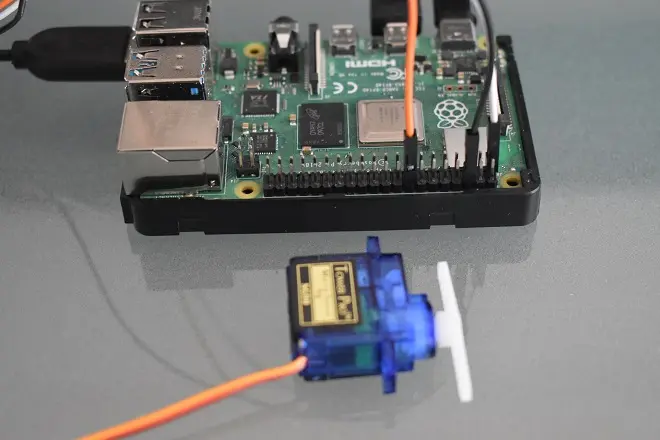
What is a Servo motor?
A servomotor or servo is an electromechanical device that allows very precise control of the speed and angular displacement of its axis, generally limited to 180 degrees. It is mainly composed of a DC motor, a speed reducer, a shaft, a control circuit, and a feedback mechanism, usually a potentiometer.
How does a Servo motor work?
A microcontroller, for example a Raspberry Pi 4, sends an electrical pulse (PWM) to the servomotor. This reads the amplitude of the pulse, through its control circuit, and drives the DC motor. The speed reducer starts up. The rotation of the shaft turns the potentiometer knob changing its output voltage. This value is used by the control circuit to calculate the position, direction and angular velocity of the shaft.
Next we will see how to rotate a servomotor 180 degrees using a Raspberry Pi 4.
Hardware required
For this project we will use a Raspberry Pi 4 and a Sunfunder 9g SG90 Micro Servo.

Circuit wiring
Servo motors typically come with three different colored wires: orange for control; red for power; and brown for ground.
Connect the servo motor cables to the Raspberry pins as follows: the orange cable to GPIO pin 23; the black wire with any of the GND pins; and the red wire with the 3.3V pin.
Python code to rotate a servo 180 degrees back and forth
import RPi.GPIO as GPIO
import time
SERVO_MIN_PULSE = 500
SERVO_MAX_PULSE = 2500
Servo = 23
def map(value, inMin, inMax, outMin, outMax):
return (outMax - outMin) * (value - inMin) / (inMax - inMin) + outMin
def setup():
global p
GPIO.setmode(GPIO.BCM)
GPIO.setup(Servo, GPIO.OUT)
GPIO.output(Servo, GPIO.LOW)
p = GPIO.PWM(Servo, 50)
p.start(0)
def setAngle(angle):
angle = max(0, min(180, angle))
pulse_width = map(angle, 0, 180, SERVO_MIN_PULSE, SERVO_MAX_PULSE)
pwm = map(pulse_width, 0, 20000, 0, 100)
p.ChangeDutyCycle(pwm)
def loop():
while True:
for i in range(0, 181, 5):
setAngle(i)
time.sleep(0.002)
time.sleep(1)
for i in range(180, -1, -5):
setAngle(i)
time.sleep(0.001)
time.sleep(1)
def destroy():
p.stop()
GPIO.cleanup()
if __name__ == '__main__':
setup()
try:
loop()
except KeyboardInterrupt:
destroy()To run the code, go to the Raspberry Pi OS desktop. Click on the Raspberry menu > Programming > mu. Copy and paste the code. Click Save and save the file with a .py extension. Finally, click Run.